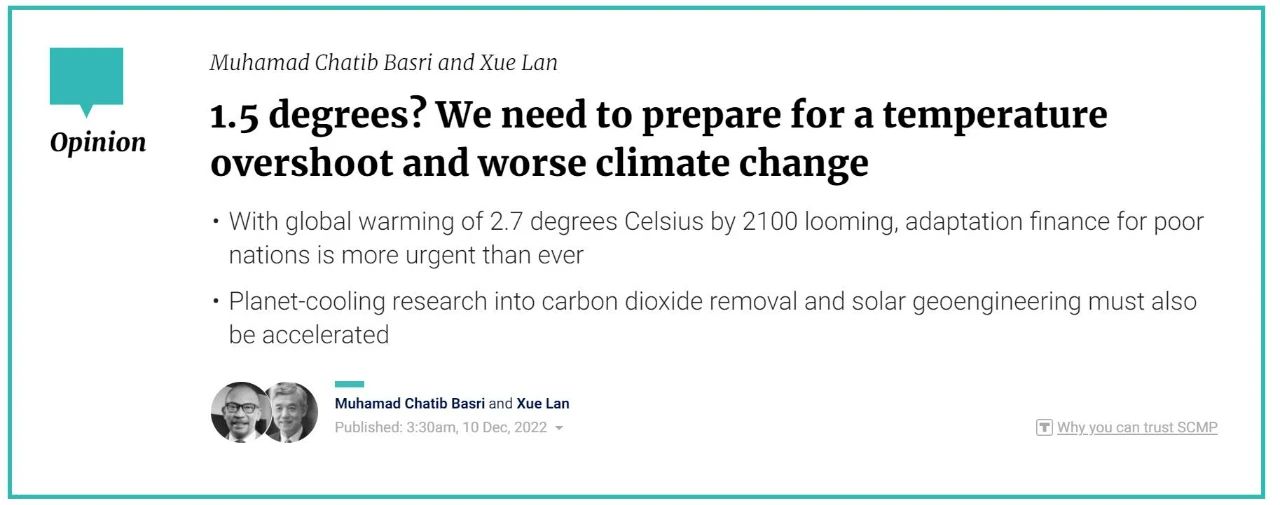编者按
《联合国气候变化框架公约》第二十七次缔约方大会(cop27)于11月6-18日在埃及沙姆沙伊赫举行。当地时间11月17日下午,气候过冲委员会(climate overshooting commission) 在cop27法国角举办了题为”降低温升可能超过1.5℃的风险“的cop27边会。近日,气候过冲委员会委员,清华大学文科资深教授、苏世民书院院长、清华大学全球可持续发展研究院院长薛澜教授以及气候过冲委员会委员、印尼前财政部长muhammad chatib basri(穆罕默德·查蒂布·巴斯里)在《南华早报》发表观点文章:1.5 degrees? we need to prepare for a temperature overshoot and worse climate change(《1.5度?我们需要为气温过冲和最坏的气候变化做准备》),呼吁各方应加强行动为全球温升可能超过1.5℃,及其产生的影响做好准备。以下为文章全文:

as the world’s population reaches8 billion, the consequences of our environmental impact are visible and devastating, from melting glaciers to unprecedented heatwaves and floods. these are set to intensify, in frequency and severity – while countries continue to try to reduce greenhouse gas emissions to limit global warming to 1.5 degrees celsius above pre-industrial levels.
according to the latest mathematical models and reports from the united nations and other expert organisations, however, the world is heading for an temperature increase that will overshoot 1.5 degrees, at least temporarily.
currently, we are on track for an expected warming of2.7 degrees by 2100 – quite simply, too little has been done to cut emissions. what is decided today as a response to global warming will define the climate our children and grandchildren live in.
we need to explore more approaches to minimise the impact of temperature overshoot and reduce its duration. while cutting emissions remains the highest priority, how else can societies adapt to climate impact? could and should we consider cooling the earth? how do we capture the carbon dioxide released since the industrial revolution?
the first additional approach we need to explore is adaptation to a changed climate. it was high on the cop27 agenda, as negotiators debated gaps in the adaptation funding pivotal to climate-vulnerable low and middle-income countries.
the annual us$100 billion for climate action pledged at cop15 isfar from being delivered. but even this would be insufficient. “international adaptation finance flows to developing countries are 5-10 times below estimated needs and the gap is widening,” said the un.
helping vulnerable nations cope with theloss and damage from unavoidable climate change effects is also an increasingly salient matter of equity and social justice. we need to build adaptation programmes with local communities’ ownership and adherence, deliver promised finance and advance the discussion on loss and damage.
the second approach key to reducing the magnitude and length of climate overshoot iscarbon dioxide removal. the un intergovernmental panel on climate change concluded that such removal would be unavoidable in scenarios that limit overshoot. these techniques, which are being developed largely in high-income countries, are lacking in developing ones, where nature-based solutions should be enhanced and accelerated by technological additions.
in addition to tech transfers and local capacity development, the full implications of carbon dioxide removal for social, economic and cultural rights, and for the livelihoods of diverse communities and populations need to be fully taken into account.
the last approach, a more debated one, is solar radiation modification (srm) or what experts call solar geoengineering. this would artificially lower the planet’s temperature, perhaps by mimicking the natural cooling effect of volcanic eruptions. srm appears able to rapidly and inexpensively reduce global warming, but bears risks, uncertainties and serious governance challenges.
one challenge is that its reportedly low cost and technical feasibility implies that a single country could undertake it, with global spillover effects. the chance of unilateral deployment could be lessened by putting srm on the international agenda to increase cooperation and collaboration.
another challenge is that information on srm effectiveness remains limited and inconclusive, making it a non-viable option. but this research should still be developed as a last resort if and when climate overshoot is unavoidable through emission cuts alone.
rarely has the world been at such an intersection of issues, with compounding local, regional and global problems. in the face of wars, global health threats and serious economic difficulties, policymakers need to strengthen their response to climate change by choosing the most effective, fair and cost-effective solutions.
the integration of carbon dioxide removal and solar geoengineering into climate-related economic models could provide large economic benefits, in trillions of dollars per year of avoided damage, especially for low- and middle-income countries in warming climates. it is time for governments to assess the benefits, costs and risks of each of these approaches, as they do for every public policy or service provided.
we look forward to accompanying them through our work at the climate overshoot commission, and to supporting them in identifying the best and most cost-effective models to address the likely risk of temperature overshoot.
作者简介
muhamad chatib basri(穆罕默德·查蒂布·巴斯里)
气候过冲委员会委员、印度尼西亚前财政部长
薛澜
气候过冲委员会委员,清华大学文科资深教授、苏世民书院院长、清华大学全球可持续发展研究院院长
来源丨南华早报
供稿丨清华大学全球可持续发展研究院